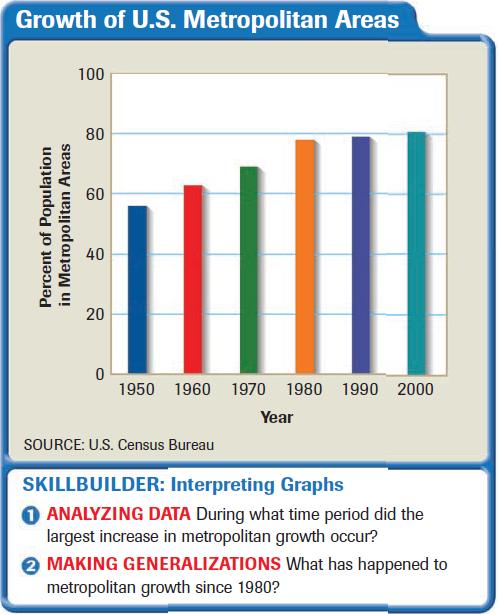Urban Sprawl
A HUMAN PERSPECTIVE Richard Baron is a real estate developer who tried to address the related problems of urban sprawl and inadequate low-income housing. In 1996, he began building Murphy Park, an affordable and attractive housing complex in mid-town St. Louis, Missouri.
The development has more than 400 units and contains both apartments and townhouses. It has plenty of green space, art and day-care centers, and an elementary school. More than half of Murphy Park's units are reserved for people with low income. Baron's solution—to bring the attractive features of suburban living to the city—is one of many that are being applied to the problem of urban sprawl.
Growth Without a Plan
Those Americans and Canadians who can afford it often choose to work in a city but live in its suburbs. They are usually attracted by new, upscale housing, better public services, and open space. As suburbs become more numerous, metropolitan areas become larger and more difficult to manage.

URBAN SPRAWL
Poorly planned development that spreads a city's population over a wider and wider geographical area is called urban sprawl. As outlying areas become more populated, the land between them and the city fills in as well.
In the United States and Canada, urban sprawl is becoming a matter of increasing concern. From 1970 to 2000, people who worked in U.S. cities moved farther and farther from urban centers. The population density of cities in the United States decreased by more than 20 percent as people in cities moved to suburbs and outlying areas. About 30,000 square miles of rural lands were gobbled up by housing developments. For example, the population of the city of Chicago decreased during this period from 3.4 million people to 2.8 million. But the Chicago metropolitan area grew from about 7.0 million persons to 7.3 million.
Canada is less populated than the United States but faces similar problems. In the 1990s, more than 75 percent of all Canadians lived in urban areas.
CAUSES OF URBAN SPRAWL
Sprawl occurs in metropolitan areas that allow unrestricted growth or that have no plans to contain it. Other factors include the widespread use of automobiles and the building of expressways. Autos and relatively cheap gasoline enable Americans to drive many miles to and from their jobs. Despite clogged highways and long commutes, Americans prefer their cars to mass transit. Expressways provide the means for continued reliance on the automobile.
Yet, despite sprawl, there are many reasons why Americans have moved to suburbs. Some people want open spaces or better schools and housing. Still others want to try to recapture the sense of community they experienced while growing up. They want their children to know their neighbors and have a backyard in which to play. Only recently have urban planners started to design big-city neighborhoods to give a sense of community, hoping to slow the flight to the suburbs.
Urban Sprawl's Negative Impact
Urban sprawl has a negative impact on the quality of life in many ways. As suburbs grow, more commuter traffic strains the infrastructure. Infrastructure consists of the basic facilities, services, and machinery needed for a community to function. For example, roads and bridges need maintenance. More cars on the road for more time adds to air pollution, too. Also, sources of water, such as rivers or underground aquifers (layers of water-holding rock or soil), become depleted. Urban sprawl also has other costs. The cost of providing streets, utilities, and other public facilities to suburban communities is often at least 25 per cent higher than for high-density residences in a city. Urban sprawl also separates classes of people. When those in upper-income brackets choose to live in outlying areas, lower-income residents often become isolated in inner-city areas.
Solutions to Sprawl
More and more cities are developing plans for smart growth, which is the efficient use and conservation of land and other resources. Most often this involves encouraging development close to or inside the limits of existing cities. Good public transportation systems help to make smart growth possible by cutting down on auto traffic.
PORTLAND'S GROWTH BOUNDARY
In 1979, the city of Portland, Oregon, drew a line around itself to create an urban growth boundary. Building was allowed inside the boundary. The surrounding green space was off limits to developers. This decision caused controversy but has paid off. Portland has contained urban sprawl.
VANCOUVER'S PLAN FOR SUSTAINABLE COMMUNITIES
Since 1961, Vancouver, British Columbia, has seen the population of its metropolitan area double. The growth of outlying suburbs often took place at the expense of forests, farms, and flood plains. In 1995, the Greater Vancouver Regional Board adopted a plan to manage growth. It involved turning suburbs into sustainable communities, that is, communities where residents could live and work. The same solution was applied to Vancouver's downtown area, where about 40 percent of its residents now walk to work. This has cut down on commuting.
GRASSROOTS OPPOSITION
In some metropolitan areas, citizens have banded together to offer their own solutions to urban sprawl. For example, citizens in Durham, North Carolina, opposed additional commercial development along a congested area of a nearby interstate highway. They formed CAUSE—Citizens Against Urban Sprawl Everywhere. The organization is working against sprawl through education and political activism. In this section, you read about the challenge of urban sprawl. In the Case Study that follows, you will learn about challenges increasingly diverse societies bring to the United States and Canada.